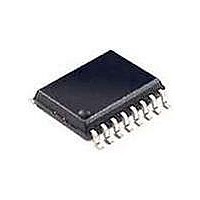SI3050-KT Silicon Laboratories Inc, SI3050-KT Datasheet - Page 32

SI3050-KT
Manufacturer Part Number
SI3050-KT
Description
IC VOICE DAA GCI/PCM/SPI 20TSSOP
Manufacturer
Silicon Laboratories Inc
Type
Chipsetr
Specifications of SI3050-KT
Package / Case
20-TSSOP
Function
Data Access Arrangement (DAA)
Interface
PCM, Serial, SPI
Number Of Circuits
1
Voltage - Supply
3 V ~ 3.6 V
Current - Supply
8.5mA
Operating Temperature
0°C ~ 70°C
Mounting Type
Surface Mount
Includes
Line Voltage Monitor, Loop Current Monitor, Overload Detection, Parallel Handset Detection, Polarity Reversal Detection, TIP and
Product
Modem Chip
Supply Voltage (min)
3 V
Supply Current
8.5 mA
Maximum Operating Temperature
+ 70 C
Minimum Operating Temperature
0 C
Mounting Style
SMD/SMT
Lead Free Status / RoHS Status
Contains lead / RoHS non-compliant
Power (watts)
-
Lead Free Status / RoHS Status
Lead free / RoHS Compliant, Contains lead / RoHS non-compliant
Available stocks
Company
Part Number
Manufacturer
Quantity
Price
Part Number:
SI3050-KT
Manufacturer:
SILICONIX
Quantity:
20 000
Company:
Part Number:
SI3050-KTR
Manufacturer:
NEC
Quantity:
947
Part Number:
SI3050-KTR
Manufacturer:
SILICON LABS/芯科
Quantity:
20 000
Si3050
enable
requirements. Thresholds are set so that a ring signal is
guaranteed to not be detected below the minimum, and
a ring signal is guaranteed to be detected above the
maximum.
Pulse Dialing and Spark Quenching
Pulse dialing is accomplished by going off- and on-hook
to generate make and break pulses. The nominal rate is
10 pulses per second. Some countries have strict
specifications for pulse fidelity including make and
break times, make resistance, and rise and fall times. In
a traditional, solid-state dc holding circuit, there are a
number of issues in meeting these requirements.
The Si3050 dc holding circuit has active control of the
on- and off-hook transients to maintain pulse dialing
fidelity.
Spark quenching requirements in countries, such as
Italy, the Netherlands, South Africa, and Australia, deal
with the on-hook transition during pulse dialing. These
tests provide an inductive dc feed resulting in a large
voltage spike. This spike is caused by the line
inductance and the sudden decrease in current through
the loop when going on-hook. The traditional way of
dealing with this problem is to put a parallel RC shunt
across the hookswitch relay. The capacitor is large
(~1 µ F, 250 V) and relatively expensive. In the Si3050,
loop current can be controlled to achieve three distinct
on-hook speeds to pass spark quenching tests without
additional BOM components. Through the settings of
four bits in three registers, OHS (Register 16), OHS2
(Register 31), SQC0, and SQC1 (Register 59), a slow
ramp down of loop current can be achieved which
induces a delay between the time the OH bit is cleared
and the time the DAA actually goes on-hook.
To ensure proper operation of the DAA during pulse
dialing, disable the automatic resistor calibration that is
performed each time the DAA enters the off-hook state
by setting the RCALD bit (Register 25, bit 5).
32
satisfaction
of
global
ringer
threshold
Rev. 1.0
Billing Tone Detection and
Receive Overload
“Billing tones” or “metering pulses” generated by the
central office can cause modem connection difficulties.
The billing tone is typically either a 12 or 16 kHz signal
and is sometimes used in Germany, Switzerland, and
South Africa. Depending on line conditions, the billing
tone might be large enough to produce major errors in
the line data. The Si3050/19 chipset can provide
feedback indicating the beginning and end of a billing
tone.
Billing tones less than 1.1 V
by the low-pass digital filter on the Si3050/19. The ROV
bit is set when a billing tone is greater than 1.1 V
indicating a receive overload condition. The BTD bit is
set when a billing tone is large enough to excessively
reduce the line-derived power supply of the line-side
device (Si3018/19).
The OVL bit (Register 19) can be polled following billing
tone detection. After the OVL bit returns to 0, this
indicates that the billing tone has passed. The ROV bit
is sticky and must be written to 0 to be reset. After the
billing tone passes, the DAA initiates an auto-calibration
sequence that must complete before data can be
transmitted.
Certain line events, such as an off-hook event on a
parallel phone or a polarity reversal, can trigger the
ROV or the BTD bits, after which the ROV bit must be
reset. The user should look for multiple events before
qualifying whether billing tones are actually present.
Although the DAA remains off-hook during a billing tone
event, the received data from the line is corrupted when
a large billing tone occurs. To receive data through a
billing tone, an external LC filter must be added. A
manufacturer can provide this filter to users in the form
of a dongle that connects on the phone line before the
DAA. This relieves the manufacturer of providing a
costly internal LC filter when it may only be necessary to
support a few countries/customers.
Alternatively, when a billing tone is detected, the system
software can notify the user that a billing tone has
occurred. This notification is used to prompt the user to
contact the telephone company to disable the billing
tones or to purchase an external LC filter.
PK
on the line are filtered out
PK
,












